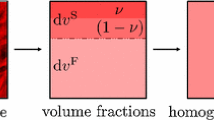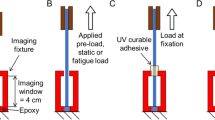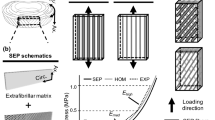Abstract
Accurate techniques for simulating the deformation of soft biological tissues are an increasingly valuable tool in many areas of biomechanical analysis and medical image computing. To model the complex morphology and response of articular cartilage, a hyperviscoelastic (dispersed) fiber-reinforced constitutive model is employed to complete two specimen-specific finite element (FE) simulations of an indentation experiment, with and without considering fiber dispersion. Ultra-high field Diffusion Tensor Magnetic Resonance Imaging (17.6 T DT-MRI) is performed on a specimen of human articular cartilage before and after indentation to ∼20% compression. Based on this DT-MRI data, we detail a novel FE approach to determine the geometry (edge detection from first eigenvalue), the meshing (semi-automated smoothing of DTI measurement voxels), and the fiber structural input (estimated principal fiber direction and dispersion). The global and fiber fabric deformations of both the un-dispersed and dispersed fiber models provide a satisfactory match to that estimated experimentally. In both simulations, the fiber fabric in the superficial and middle zones becomes more aligned with the articular surface, although the dispersed model appears more consistent with the literature. In the future, a multi-disciplinary combination of DT-MRI and numerical simulation will allow the functional state of articular cartilage to be determined in vivo.












Similar content being viewed by others
References
Abdullah, O. M., S. F. Othman, X. J. Zhou, and R. L. Magin. Diffusion tensor imaging as an early marker for osteoarthritis. Proc. Intl. Soc. Magn. Reson. Med. 15:814, 2007.
Alexander, A. L., K. Hasan, G. Kindlmann, D. L. Parker, and J. S. Tsuruda. A geometric analysis of diffusion tensor measurements of the human brain. Magn. Reson. Med. 44:283–291, 2000.
Arsigny, V., P. Fillard, X. Pennec, and N. Ayache. Geometric means in a novel vector space structure on symmetric positive-definite matrices. SIAM J. Matrix Anal. Appl. 29:328–347, 2006.
Bachrach, N. M., V. C. Mow, and F. Guilak. Incompressibility of the solid matrix of articular cartilage under high hydrostatic pressures. J. Biomech. 31:445–451, 1998.
Bastin, M. E., P. A. Armitage, and I. Marshall. A theoretical study of the effect of experimental noise on the measurement of anisotropy in diffusion imaging. Magn. Reson. Imaging 16(7):773–785, 1998.
Benninghoff, A. Form und Bau der Gelenkknorpel in ihren Beziehungen zur Funktion. II. Der Aufbau des Gelenkknorpels in seinen Beziehungen zur Funktion. Zeitschrift für Zellforschung und mikroskopische Anatomie 2:783–862, 1925.
Bodammer, N., J. Kaufmann, M. Kanowski, and C. Tempelman. Eddy current correction in diffusion-weighted imaging using pairs of images acquired with opposite diffusion gradient polarity. Magn. Reson. Med. 51:188–193, 2004.
Boskey, A., and N. P. Camacho. FT-IR imaging of native and tissue-engineered bone and cartilage. Biomaterials 28:2465–2478, 2007.
Broom, N. D. Further insights into the structural principles governing the function of articular cartilage. J. Anat. 139:275–294, 1984.
Broom, N. D., and R. Flachsmann. Physical indicators of cartilage health: the relevance of compliance, thickness, swelling and fibrillar texture. J. Anat. 202:481–494, 2003.
Burstein, D., and M. L. Gray. Is MRI fulfilling its promise for molecular imaging of cartilage in arthritis? Osteoarthr. Cartil. 14:1087–1090, 2006.
Charlebois, M., M. D. McKee, and M. D. Buschmann. Nonlinear tensile properties of bovine articular cartilage and their variation with age and depth. J. Biomech. Eng. 126:129–137, 2004.
Clark, J. M. The organization of collagen fibrils in the superficial zones of articular cartilage. J. Anat. 171:117–130, 1990.
Demiray, H. A note on the elasticity of soft biological tissues. J. Biomech. 5:309–311, 1972.
Deng, X., M. Farley, M. T. Nieminen, M. Gray, and D. Burstein. Diffusion tensor imaging of native and degenerated human articular cartilage. Magn. Reson. Med. 25(2):168–171, 2007.
de Visser, S. K., J. C. Bowden, E. Wentrup-Bryne, L. Rintoul, T. Bostrom, J. M. Pope, and K. I. Momot. Anisotropy of collagen fibre alignment in bovine cartilage: comparison of polarised light microscopy and spatially resolved diffusion-tensor measurements. Osteoarthr. Cartil. 16:689–697, 2008.
de Visser, S. K., R. W. Crawford, and J. M. Pope. Structural adaptations in compressed articular cartilage measured by diffusion tensor imaging. Osteoarthr. Cartil. 16:83–89, 2008.
DiSilvestro, M. R., and J.-K. F. Suh. A cross-validation of the biphasic poroviscoelastic model of articular cartilage in unconfined compression, indentation, and confined compression. J. Biomech. 34:519–525, 2001.
Ennis, D. B., G. Kindlman, I. Rodriguez, P. A. Helm, and E. R. McVeigh. Visualization of tensor fields using superquadric glyphs. Magn. Reson. Med. 53:169–176, 2005.
Filidoro, L., O. Dietrich, J. Weber, E. Rauch, T. Oether, M. Wick, M. F. Reiser, and C. Glaser. High-resolution diffusion tensor imaging of human patellar cartilage: feasibility and preliminary findings. Magn. Reson. Med. 53:993–998, 2005.
García, J. J., and D. H. Cortés. A biphasic viscohyperelastic fibril-reinforced model for articular cartilage: formulation and comparison with experimental data. J. Biomech. 40:1737–1744, 2007.
Gasser, T. C., R. W. Ogden, and G. A. Holzapfel. Hyperelastic modelling of arterial layers with distributed collagen fibre orientations. J. R. Soc. Interface 3:15–35, 2006.
Gere, J. M., and S. P. Timoshenko. Mechanics of Materials, 4th edn. Boston, MA: PWS-KENT Pub. Co., 1997.
Glaser, C., and R. Putz. Functional anatomy of articular cartilage under compressive loading quantitative aspects of global, local and zonal reactions of the collagenous network with respect to the surface integrity. Osteoarthr. Cartil. 10:83–99, 2002.
Hayes, W. C., and A. J. Bodine. Flow-independent viscoelastic properties of articular cartilage matrix. J. Biomech. 11:407–419, 1978.
Holzapfel, G. A. Nonlinear Solid Mechanics. A Continuum Approach for Engineering. Chichester: Wiley, 2000.
Holzapfel, G. A., and T. C. Gasser. A viscoelastic model for fiber-reinforced composites at finite strains: Continuum basis, computational aspects and applications. Comput. Meth. Appl. Mech. Eng. 190:4379–4403, 2001.
Holzapfel, G. A., T. C. Gasser, and R. W. Ogden. A new constitutive framework for arterial wall mechanics and a comparative study of material models. J. Elasticity 61:1–48, 2000.
Holzapfel, G. A., T. C. Gasser, and R. W. Ogden. Comparison of a multi-layer structural model for arterial walls with a Fung-type model, and issues of material stability. J. Biomech. Eng. 126:264–275, 2004.
Huang, C.-Y., A. Stankiewicz, G. A. Ateshian, and V. C. Mow. Anisotropy, inhomogeneity, and tension-compression nonlinearity of human glenohumeral cartilage in finite deformation. J. Biomech. 38:799–809, 2005.
Jeffery, A. K., G. W. Blunn, C. W. Archer, and G. Bentley. Three-dimensional collagen architecture in bovine articular cartilage. J. Bone Joint Surg. Br. 73:795–801, 1991.
Julkunen, P., P. Kiviranta, W. Wilson, J. S. Jurvelin, and R. K. Korhonen. Characterization of articular cartilage by combining microscopic analysis with a fibril-reinforced finite-element model. J. Biomech. 40:1862–1870, 2007.
Julkunen, P., R. K. Korhonen, W. Herzog, and J. S. Jurvelin. Uncertainties in indentation testing of articular cartilage: a fibril-reinforced poroviscoelastic study. Med. Eng. Phys. 30:506–515, 2008.
Jurvelin, J. S., M. D. Buschmann, and E. B. Hunziker. Optical and mechanical determination of Poisson’s ratio of adult bovine humeral articular cartilage. J. Biomech. 30:235–241, 1997.
Kaab, M. J., I. A. Gwynn, and H. P. Notzli. Collagen fibre arrangement in the tibial plateau articular cartilage of man and other mammalian species. J. Anat. 193:23–34, 1998.
Kaab, M. J., K. Ito, J. M. Clark, and H. P. Notzli. Deformation of articular cartilage collagen structure under static and cyclic loading. J. Orthop. Res. 16:743–751, 1998.
Kaab, M. J., K. Ito, B. Rahn, J. M. Clark, and H. P. Notzli. Effect of mechanical load on articular cartilage collagen structure: a scanning electron-microscope study. J. Anat. 167:106–120, 2000.
Kiousis, D. E., T. C. Gasser, and G. A. Holzapfel. Smooth contact strategies with emphasis on the modeling of balloon angioplasty with stenting. Int. J. Numer. Meth. Eng. 75:826–855, 2008.
Le Bihan, D., J.-F. Mangin, C. Poupon, C. A. Clark, S. Pappata, N. Molko, and H. Chabriat. Diffusion tensor imaging: concepts and applications. J. Musculoskel. Neuron. Interact. 13:534–546, 2001.
Li, L. P., and W. Herzog, The role of viscoelasticity of collagen fibers in articular cartilage: theory and numerical formulation. Biorheology 41:181–194, 2004.
Li, L. P., J. Soulhat, M. D. Buschmann, and A. Shirazi-Adl. Nonlinear analysis of cartilage in unconfined ramp compression using a fibril reinforced poroelastic model. Clin. Biomech. 14:673–682, 1999.
Marr, D., and E. Hildreth. Theory of edge detection. Proc. R. Soc. Lond. B 207:187–217, 1980.
Mattiello, J., J. P. Basser, and D. Le Bihan. The b matrix in diffusion tensor echo-planar imaging. Magn. Reson. Med. 37:292–300, 1997.
Meder, R., S. K. de Visser, J. C. Bowden, T. Bostrom, and J. M. Pope. Diffusion tensor imaging of articular cartilage as a measure of tissue microstructure. Osteoarthr. Cartil. 14:875–881, 2006.
Moger, C. J., R. Barrett, P. Bleuet, D. A. Bradley, R. E. Ellis, E. M. Green, K. M. Knapp, P. Muthuvelu, and C. P. Winlove. Regional variations of collagen orientation in normal and diseased articular cartilage and subchodral bone determined using small angle X-ray scattering (SAXS). Osteoarthr. Cartil. 15:682–687, 2007.
Mollenhauer, J., M. Aurich, C. Muehleman, G. Khelashvilli, and T. C. Irvine. X-ray diffraction of the molecular substructure of human articular cartilage. Connect. Tissue Res. 44:201–207, 2003.
Mow, V. C., W. Y. Gu, and F. H. Chen. Structure and function of articular cartilage and meniscus. In: Basic Orthopaedic Biomechanics & Mechano-Biology, 3rd edn., edited by V. C. Mow and R. Huiskes. Philadelphia: Lippincott Williams & Wilkins, 2005, pp. 181–258.
Muehleman, C., S. Majumdar, A. S. Issever, F. A. R.-H. Menk, L. Rigon, G. Heitner, B. Reime, J. Metge, A. Wagner, K. E. Kuettner, and J. Mollenhauer. X-ray detection of structural orientation in human articular cartilage. Osteoarthr. Cartil. 12:97–105, 2004.
Neeman, M., J. P. Freyer, and L. O. Sillerud. A simple method for obtaining cross-term-free images for diffusion anisotropy studies in NMR microimaging. Magn. Reson. Med. 21:138–143, 1991.
Park, S., R. Krishnan, S. B. Nicoll, and G. A. Ateshian. Cartilage interstitial fluid load support in unconfined compression. J. Biomech. 36:1785–1796, 2003.
Pierce, D. M., W. Trobin, S. Trattnig, H. Bischof, and G. A. Holzapfel. A phenomenological approach toward patient-specific computational modeling of articular cartilage including collagen fiber tracking. J. Biomed. Eng. 131:091006, 2009.
Potter, H. G., B. R. Black, and L. R. Chong. New techniques in articular cartilage imaging. Clin. Sports Med. 28:77–94, 2009.
Quinn, T. M., and V. Morel. Microstructural modeling of collagen network mechanics and interactions with the proteoglycan gel in articular cartilage. Biomech. Model. Mechanobiol. 6:73–82, 2007.
Roth, V., and V. C. Mow. The intrinsic tensile behavior of the matrix of bovine articular cartilage and its variation with age. J. Bone Joint Surg. 62:1102–1117, 1980.
Schmidt, M. B., V. C. Mow, L. E. Chun, and D. R. Eyre. Effects of proteoglycan extraction on the tensile behavior of articular cartilage. J. Orthop. Res. 8:353–363, 1990.
Silver, F. H., G. Bradica, and A. Tria. Viscoelastic behavior of osteoarthritic cartilage. Connect. Tissue Res. 42:223–233, 2001.
Simo, J. C. On a fully three-dimensional finite-strain viscoelastic damage model: formulation and computational aspects. Comput. Meth. Appl. Mech. Eng. 60:153–173, 1987.
Simo, J. C., R. L. Taylor, and K. S. Pister. Variational and projection methods for the volume constraint in finite deformation elasto-plasticity. Comput. Meth. Appl. Mech. Eng. 51:177–208, 1985.
Taylor, R. L. FEAP—A Finite Element Analysis Program, Version 8.2 User Manual. University of California at Berkeley, Berkeley, California, 2007.
Taylor, Z. A., O. Comas, M. Cheng, J. Passenger, D. J. Hawkes, D. Atkinson, and S. Ourselin. On modelling of anisotropic viscoelasticity for soft tissue simulation: numerical solution and GPU execution. Med. Image Anal. 13:234–244, 2009.
Ugryumova, N., D. P. Attenburow, C. P. Winlove, and S. J. Matcher. The collagen structure of equine articular cartilage, characterized using polarization-sensitive optical coherence tomography. J. Phys. D: Appl. Phys. 38:2612–2619, 2005.
Ugryumova, N., S. V. Gangnus, and S. J. Matcher. Three-dimensional optic axis determination using variable-incidence-angle polarization-optical coherence tomography. Opt. Lett. 31:2305–2307, 2006.
Wilson, W., J. M. Huyghe, and C. C. van Donkelaar. A composition-based cartilage model for the assessment of compositional changes during cartilage damage and adaptation. Osteoarthr. Cartil. 14:554–560, 2006.
Wilson, W., J. M. Huyghe, and C. C. van Donkelaar. Depth-dependent compressive equilibrium properties of articular cartilage explained by its composition. Biomech. Model. Mechanobiol. 43–53, 2007.
Wilson, W., C. C. van Donkelaar, B. van Rietbergen, K. Ito, and R. Huiskes. Stresses in the local collagen network of articular cartilage: a poroviscoelastic fibril-reinforced finite element study. J. Biomech. 37:357–366, 2004.
Wilson, W., C. C. van Donkelaar, B. van Rietbergen, and R. Huiskes. A fibril-reinforced poroviscoelastic swelling model for articular cartilage. J. Biomech. 38:1195–1204, 2005.
Witkin, A. P. Scale-space filtering. In: Proceedings of the International Joint Conference on Artificial Intelligence, 1983, pp. 1019–1022.
Wong, M., M. Ponticiello, V. Kovanen, and J. S. Jurvelin. Volumetric changes of articular cartilage during stress relaxation in unconfined compression. J. Biomech. 33:1049–1054, 2000.
Woo, S. L. Y., B. R. Simon, S. C. Kuei, and W. H. Akeson. Quasi-linear viscoelastic properties of normal articular cartilage. J. Biomech. Eng. 102:85–90, 1980.
Xia, Y. Resolution ‘scaling law’ in MRI of articular cartilage. Osteoarthr. Cartil. 15:363–365, 2007.
Xia, Y., J. B. Moody, and H. Alhadlaq. Orientational dependence of T2 relaxation in articular cartilage: a microscopic MRI (microMRI) study. Magn. Reson. Med. 48:460–469, 2002.
Zhu, W., V. C. Mow, T. J. Koob, and D. R. Eyre. Viscoelastic shear properties of articular cartilage and the effects of glycosidase treatments. J. Orthop. Res. 11:771–781, 1993.
Acknowledgments
We gratefully acknowledge the financial support of the Austrian Science Fund through project P-18110-B15 ‘Visualization of biomechanics of articular cartilage by MRI’. In addition, we acknowledge Dimitris Kiousis for several lengthy discussions and support regarding the use of a custom smooth contact algorithm, as well as general support regarding FEAP.
Author information
Authors and Affiliations
Corresponding author
Additional information
Associate Editor Michael S. Detamore oversaw the review of this article.
Rights and permissions
About this article
Cite this article
Pierce, D.M., Trobin, W., Raya, J.G. et al. DT-MRI Based Computation of Collagen Fiber Deformation in Human Articular Cartilage: A Feasibility Study. Ann Biomed Eng 38, 2447–2463 (2010). https://doi.org/10.1007/s10439-010-9990-9
Received:
Accepted:
Published:
Issue Date:
DOI: https://doi.org/10.1007/s10439-010-9990-9




